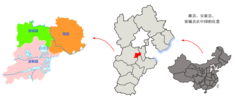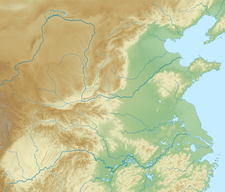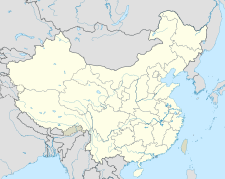| Xiong'an 雄 安 新区 | |
|---|---|
| Nueva área de Xiong'an | |
 Centro de servicio al ciudadano de Xiong'an en el condado de Rongcheng | |
 | |
 Ubicación de la nueva zona de Xiong'an en Hebei | |
| Coordenadas: 39 ° 02′55 ″ N 115 ° 54′13 ″ E / 39.0484971°N 115.9037414°E Coordenadas : 39 ° 02′55 ″ N 115 ° 54′13 ″ E / 39.0484971°N 115.9037414°E | |
| País | República Popular de China |
| Provincia | Hebei |
| Ciudad a nivel de prefectura | Baoding |
| Se establece el gobierno de distrito | 1 de abril de 2017 |
| Gobierno | |
| • Secretario interino del partido | Chen Gang [1] |
| Área | |
| • Total | 100 km 2 (40 millas cuadradas) |
| Zona horaria | UTC + 8 ( hora estándar de China ) |
| Sitio web | english.xiongan.gov.cn |
Xiong'an New Area ( chino simplificado :雄 安 新区; chino tradicional :雄 安 新區; pinyin : Xióng'ān Xīnqū ) es una nueva área a nivel estatal en el área de Baoding de Hebei , China. [2] Establecida en abril de 2017, el área está ubicada a unos 100 km al suroeste de Beijing y 50 km al este del centro de Baoding . Su función principal es servir como centro de desarrollo para Beijing-Tianjin-Hebei ( Jingjinji) triángulo económico. Además, se espera que las funciones "no esenciales" de la capital china migren aquí, incluidas las oficinas de algunas empresas estatales, agencias gubernamentales e instalaciones de investigación y desarrollo.
El área cubre los condados de Xiong , Rongcheng y Anxin . Su nombre es un compuesto de los primeros elementos de los nombres de dos de ellos: Xiong y Anxin. [3] La construcción del área se describe como parte de la "estrategia del milenio" (千年 大计). A diferencia de otras " áreas nuevas ", el desarrollo de Xiong'an se lleva a cabo bajo la supervisión directa del Comité Central del Partido Comunista de China y el Consejo de Estado . [4] La oficina de gobierno temporal de la Nueva Área se encuentra en el Hotel Internacional Ao Wei (Mansión Ao Wei) en Rongcheng. [5]
Historia [ editar ]
By 2014, China's central government was considering to relocate a number of Beijing's administrative and back-office functions to Baoding. According to the memoir Dealing with China by US Treasury Secretary Henry Paulson, Xi Jinping, General Secretary of the Communist Party of China, told him personally in July 2014, and said the idea his "own personal initiative".[6]
The name and the location of the New Area was confirmed on March 24, 2016 at a meeting of Politburo Standing Committee of the Communist Party of China.[7]
The announcement of the New Area was released to public out of the blue[according to whom?] on the afternoon of April 1, 2017. The information was so confidential that local government didn't know it in advance.[8] Xi Jinping's visiting accompanied by Xu Kuangdi, former leader of Pudong New District, to Anxin on February 23, 2017 was revealed for the first time by news program Xinwen Lianbo on that night.[9]
Geography[edit]
It has an initial phase development area of 100 km2, composed of 60 villages in Rongcheng and Anxin.[10] The New Area would plan to be eventually expanded to 2000 km2 in the future.[11]
Baiyang Lake, northern China's largest freshwater wetland, is also included within the new area.
Administrative divisions[edit]
Xiong'an New Area consists of 3 counties:
| Map | |||||||||||||
|---|---|---|---|---|---|---|---|---|---|---|---|---|---|
 BaiyangLake AnxinCounty XiongCounty RongchengCounty | |||||||||||||
| Division code[12] | English name | Simp. Chinese | Pinyin | Area in km2[13] | Seat | Postal code | Divisions[14] | ||||||
| Towns | Townships | Residential communities | Villages | ||||||||||
| Xiong'an New Area | 雄安新区 | Xióng'ān Xīnqū | 106.46 | Rongcheng County | 20(+2) | 9(+2) | 16 | 557(+110) | |||||
| 130629 | Rongcheng County | 容城县 | Róngchéng Xiàn | 311 | Rongcheng (容城镇) | 071700 | 5 | 3 | 4 | 127 | |||
| 130632 | Anxin County | 安新县 | Ānxīn Xiàn | 728 | Anxin (安新镇) | 071600 | 9 | 3(+1) | 5 | 207(+16) | |||
| 130638 | Xiong County | 雄县 | Xióng Xiàn | 513 | Xiongzhou (雄州镇) | 071800 | 6(+2) | 3(+1) | 7 | 223(+94) | |||
| |||||||||||||
Transportation[edit]
Railway[edit]
Baigou railway station and Baiyangdian railway station, on Tianjin–Baoding intercity railway, are within reach.
Xiong'an railway station, on the Beijing–Xiong'an intercity railway, was opened on 2020-12-27.[15]
Airport[edit]
Beijing Daxing International Airport (opened in 2019) serves the area.
Expressway[edit]
It is currently served by two expressways, G45 and G18.
Real estate[edit]
A flood of footloose capital, much of it from Beijing, has been searching for properties in Xiong'an to invest, causing real estate price in this area to skyrocket rapidly since the announcement of the New Area. Local government has since imposed a temporary ban on new property sales.[16][17] The model of real estate development in the New Area may use public housing in Singapore for reference, according to a senior officer's interview on People's Daily on April 5, 2017.[18]
Activist open letter[edit]
In a February 2020 open letter of activist Xu Zhiyong addressed to Chinese Paramount leader Xi Jinping, the project is cited as an instance in which Xi had allegedly shown lack of capability in office. Xu was arrested later that month.[19]
References[edit]
- ^ 成立两个月 雄安新区临时党委书记换将. caixin.com. 2017-06-03.
- ^ 受权发布:中共中央、国务院决定设立河北雄安新区 (in Chinese). Xinhuanet. 1 April 2017. Retrieved 3 April 2017.
- ^ 权威专家谈雄安新区:本质上就是国家副都. Ifeng Finance. Southern Weekly. 2017-04-04.
- ^ China to create Xiongan New Area in Hebei, Xinhua, 2017-04-01
- ^ 雄安不眠夜:容城奥威大厦灯火通明. thepaper.cn. 2017-04-03.
- ^ 2014年7月,大大的雄安设想。书中真有黄金,屋!. xueqiu.com.
- ^ 详解雄安新区决策、选址经过. caixin.com. Xinhua. 2017-04-13.
- ^ 雄安新区成立前保密严格 筹委会官员昨“一对一”调研重点小镇. National Business Daily. 2017-04-03.
- ^ 推迟披露的行程,与这则重磅新闻相关. Beijing Youth Daily.
- ^ 雄安新区起步区为容城安新两县60村,彻底管死不增一砖一瓦. thepaper.cn. 2017-04-13. Retrieved 2017-04-13.
- ^ China to build massive city southwest of Beijing, Nikkei Asian Review, 2017-04-03.
- ^ 国家统计局统计用区划代码 Archived 2012-04-07 at the Wayback Machine
- ^ 《保定经济统计年鉴2011》
- ^ 《中国民政统计年鉴2012》
- ^ "Beijing-Xiongan high-speed railway starts service". Retrieved 2020-12-27.
- ^ 雄安新区“抢房”亲历记:24小时内的冰火两重天, 2017-04-02, 大公网
- ^ China freezes property sales in new economic zone in Hebei, Reuters
- ^ 雄安新区或借鉴新加坡模式. China Youth Daily. 2017-04-12.
- ^ Xu, Zhiyong (26 February 2020). "Dear Chairman Xi, It's Time for You to Go (Translated by Geremie R. Barmé)". China File. Retrieved 22 February 2021.
External links[edit]
- Official website


